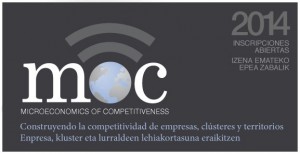We are currently warming up at Orkestra for the 2014 edition of our Microeconomics of Competitiveness (MOC) programme. This course, dedicated to fostering theoretical and practical understanding of territorial competitiveness, has been taught in the Basque Country for the last 12 years. Yet each year calls for fresh thinking among the team of faculty involved, because the competitiveness landscape and our own understanding of it are constantly evolving. My role within the programme is to teach a module on clusters and cluster policy, and for me this is a time to reflect on where this well-established yet dynamic concept fits in the context of today’s competitiveness challenges.
 Over the last twenty years clusters and cluster policies have become a key part of our understanding of what drives territorial competitiveness. This is no more evident than in Spain, where two of the world’s pioneering experiences with contemporary cluster policy emerged in the early 1990s in the Basque Country and Catalonia. Today the Spanish cluster policy landscape is a microcosm of the global scenario, being characterized by considerable heterogeneity and overlapping elements. While the primary focus of cluster policy is at regional level (with significant differences in approach among Spain’s 17 autonomous regions), there are elements of policy present also at national and European levels, alongside specific initiatives at city level.
Over the last twenty years clusters and cluster policies have become a key part of our understanding of what drives territorial competitiveness. This is no more evident than in Spain, where two of the world’s pioneering experiences with contemporary cluster policy emerged in the early 1990s in the Basque Country and Catalonia. Today the Spanish cluster policy landscape is a microcosm of the global scenario, being characterized by considerable heterogeneity and overlapping elements. While the primary focus of cluster policy is at regional level (with significant differences in approach among Spain’s 17 autonomous regions), there are elements of policy present also at national and European levels, alongside specific initiatives at city level.
The heterogeneity of cluster policy approaches found in Spain reflects the picture the world over. It is also no surprise that there are overlapping elements to policy given that the clustering of economic activities does not adhere neatly to administrative boundaries. This ‘messiness’ makes it all the more important to understand the distinction between clusters themselves, cluster policies, and specific policy instruments such as cluster associations. Certainly in the Spanish context, and also elsewhere, these are often confused.
The cluster concept refers to a real socioeconomic phenomenon; that is, the actual clustering or agglomeration, within a certain geographical proximity, of firms and other agents that are engaged in related economic activity, and the relationships that develop between them. Such clusters can exist without any associated policy, although in practice cluster policies are designed and implemented in many places to support the development of relationships within existing and/or emergent agglomerations of firms and other agents. Such cluster policies employ different types of policy instruments, and one popular instrument is to support the establishment and/or development of cluster associations that form a focal point for the relationships and activities of the clustered firms and other agents.
A starting point for many policy-makers has traditionally been to undertake some form of cluster mapping exercise, typically using data on employment or exports to identify categories of activities that are more or less concentrated. Such exercises can identify existing and emergent agglomerations and thus support the design and implementation of policies to support them. However they should be considered only as one input into the cluster policy process, alongside others. Indeed, in today’s constantly changing world we should be aware of relying too heavily on static cluster categories, and on data that is usually at best one or two years old. Such dangers have been particularly highlighted by debates around ‘smart specialization strategies’, which are premised on territories discovering activities for prioritization at the intersection of sectors, technologies and emerging markets.
In this new context it is clear that the boundaries between clusters are becoming more porous, creating new challenges for cluster policy. It becomes even more important, for example, to avoid ‘lock-in’ situations within existing clusters that have their own established institutions and collaboration dynamics. Cross-fertilization across different types of activities is a key component of the so-called entrepreneurial discovery processes that should guide smart specialization strategies, and where existing cluster structures are too rigid they can serve to re-enforce barriers. On the other hand, when harnessed properly, the social capital built within existing clusters can provide a potent springboard for cross fertilization. In this regard there are ongoing attempts in many places to foster greater inter-cluster collaboration as a route towards a new diversification/transformation of the economy.
More generally speaking the emergence of the smart specialization agenda over the last few years, and its formalization at European level in the obligation of all regions to develop a Research and Innovation Strategy for Smart Specialisation (RIS3), is certainly generating a new phase of reflection around cluster policy. As argued in a recent research paper with my colleague Mari José Aranguren, a key factor of success for regional smart specialization strategies is likely to be how well they are able to build on our existing experiences with clusters and cluster policies. Advances in how we evaluate and generate policy learning processes in the cluster sphere will also therefore be critical, but this is a topic that warrants detailed treatment in another blog post!
NOTE: At the time of publishing this post there are still a few places left on the MOC programme, which will be taught (in Spanish) in Bilbao over 8 Fridays from 14th March to 20th June. It is also possible to participate in the dedicated module on clusters, which will take place on 11th and 30th April. For more information please contact Amaia Azpiazu moc@orkestra.deusto.es.

James Wilson
James Wilson is Research Director at Orkestra-Basque Institute of Competitiveness and teaching faculty at Deusto Business School.
His research interests are in policy-relevant analysis of territorial competitiveness and socio-economic development processes.More articles by this author
-
2021-09-09
Industrial Strategy for the Long Term -
2020-10-29
Skills and clusters: Key pieces in the post-COVID resilience jigsaw -
2020-05-07
Covid, Collaboration and Clusters -
2018-06-08
Bizkaia Orekan: An Experiment in Place-Based Competitiveness Policy -
2018-04-10
Is academia a ‘weak link’ in clusters? -
2015-12-02
Smart specialisation: Learning how to do ‘new industrial policy’ -
2015-05-08
Strategies for Shaping Territorial Competitiveness -
2013-02-19
Medidas simples para aspectos complejos -
2012-11-12
El lugar importa a la hora de resolver los retos de competitividad del día de mañana -
2012-06-21
Can we create employment without fast growth?














